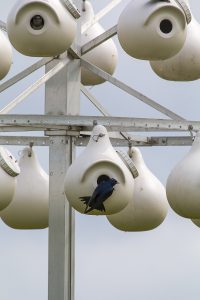Purple martins are the largest swallows in North America and are known for their aerial acrobatics and the glossy purple feathers adoring the males of this species.
Purples martins are migratory and arrive in Collier County in early February. Over the years, providing birdhouses for purple martins has become increasingly popular…and it is a wonderful thing to do for the purple martin! In fact, due to a lack of habitat in the eastern U.S., martins are dependent on human-made housing. However, this blog will discuss an oft overlooked but critical step: cleaning your nests before purple martins arrive!

So why clean your bird nests?
While martins will reuse old nesting material, our SWFL climate often facilitates the growth of mold and fungus that can damage your gourds. Even more alarmingly, old nest material can also harbor parasites.
Martins have evolved closely with parasites such as blowflies and mites. A healthy martin nestling can withstand the energy-drain that comes from losing blood to parasites. However, if food conditions are scarce or nestlings are exposed to other stressors (think noise pollution, agroechemicals, etc.), parasitism can result in the premature death of nestlings. This is because the wounds left by bloodsucking parasites can act as a portal of entry for bacteria, viruses, and protozans that anemic nestlings cannot overcome.
There are some researchers who suggest that martins suffer from higher parasitism in artificial nesting than they would under natural nesting conditions. This is because artificial nests have many cavities and result in dense living conditions that may facilitate the spread of parasites and pathogens.
Several studies have shown that cleaning nests can improve the health of nestlings and their chance of survival. You will want to clean your nests prior to the arrival of the birds in early February. We recommend removing old nesting material, then wiping the nest with a 5% bleach solution (5 parts bleach to 95 parts water), followed by a water wash to remove any bleach residue. You can also wash with a dish-washing soap detergent. You may provide dry nest material at the start of the season if you’d like, such as coarse wood shavings.
What happens once the martins arrive?
Some martin enthusiasts clean their nests during the nesting season. These articles provide more information on this practice and for more great details on the parasites of the purple martin.
https://www.purplemartin.org/uploads/media/5-1-buggingyourbirds-340.pdf
https://www.purplemartin.org/uploads/media/how-why-to-do-nest-r-332.pdf
Wait? Rewind! How do I even establish a purple martin nest?

For information on providing homes for purple martins, including nest construction, choosing a site location, and maintaining a nest: https://edis.ifas.ufl.edu/publication/UW450
What about other bird houses?
Ornithologists suggest that the practice of birdhouse cleaning should be species-specific. Some species benefit from cleaning, whereas others do not. Make sure to conduct due-diligence before cleaning your bird houses
*Hamutahl Cohen, Ph.D., is a commercial horticulture extension agent and landscape entomologist with the University of Florida, Collier County Extension Service. The Cooperative Extension Service is a branch of the University of Florida, Institute for Food and Agricultural Sciences and a department of the Public Services Division of Collier County Government. E-mail Hamutahl.cohen@ufl.edu.
 0
0
